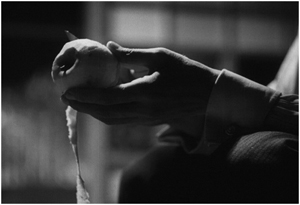June 30th Log
THE BURMESE HARP
1956, Kon Ichikawa, Japan
Repeat Viewing, DVD
Kon Ichikawa's The Burmese Harp is often celebrated among the greatest classics of Japanese cinema. This is the type of film that is moving and important. It has the power to inspire and to deeply resonant in the memory of the viewer. Made in 1956 the film deals with serious issues of pacifism and of life and death. The film is based on a novel by Michio Takeyama, and tells the story of a solider (Mizushima) who after World War 2 chooses to remain alone as a monk so he can bury the dead. Mizushima has been transcended spiritually towards enlightenment. Painful or lonely as it may be Mizushima is on a personal journey. He has gained a greater sense of meaning through the horror of war that he witnessed. The Burmese Harp expresses this through the haunting aftermath of war. The film also details this connection of the human soul with nature as we see dead bodies of soldiers throughout the peaceful contrast of the environment. The film closes with a title card reading: "In Burma, soil is red, and so are the rocks", which heightens the expression of soul and nature as a tragic one in the face of war. Today some moments may be deemed sentimental but only in the slightest. Kon Ichikawa has made a film that stands as an important one of the time, but its themes of peace and humanity deserve to be embraced on a universal level. There are so many powerful moments to this film (the soldiers singing as Mizushima plays the harp alone in the Buddha statute; Mizushima playing the harp for his friends; Mizushima’s goodbye letter). The Burmese Harp was the film that earned Ichikawa recognition throughout his native Japan and sprecifically throughout the world (it won two awards at the Venice Film Festival). It stands as a true landmark of Japanese cinema.
>>> Here is a clip from The Burmese Harp:
THE BIRDS
1963, Alfred Hitchcock, United States
Repeat Viewing, Encore
The Birds is one of the great Alfred Hitchcock’s most celebrated films. While I prefer many others over this film, The Birds is one that intrigues me with each viewing. There is such a subtle complexity and mysterious (perhaps philosophical?) depth to the film. Tippi Hedren is flawed but satisfactory enough here in the prototypical Hitchcock-blonde role. She is quite lovely, but her acting proved to be much stronger under Hitchcock’s direction in Marnie (made the following year). What is so intriguing about the film is that everything is left for interpretation and when it reaches it end, the film answers nothing and only subtly offers possibilities. Essentially the film leaves hints into a several possibilities and interpretations, but it is ultimately left for the viewer to ponder. Perhaps that is why the film has held so strong over time. Of course stylistically there is plenty of trademark Hitchcock innovation at work and some masterful sequences (most notably the now iconic moment of Hedren at the playground being surrounded by birds). There is no music to the film, but Bernard Hermann adds his presence through the sounds in the film. The Birds is (to me anyway) not Hitchcock at his very best, but it is among his most simple and mysterious.



0 Comments:
Post a Comment
Subscribe to Post Comments [Atom]
<< Home